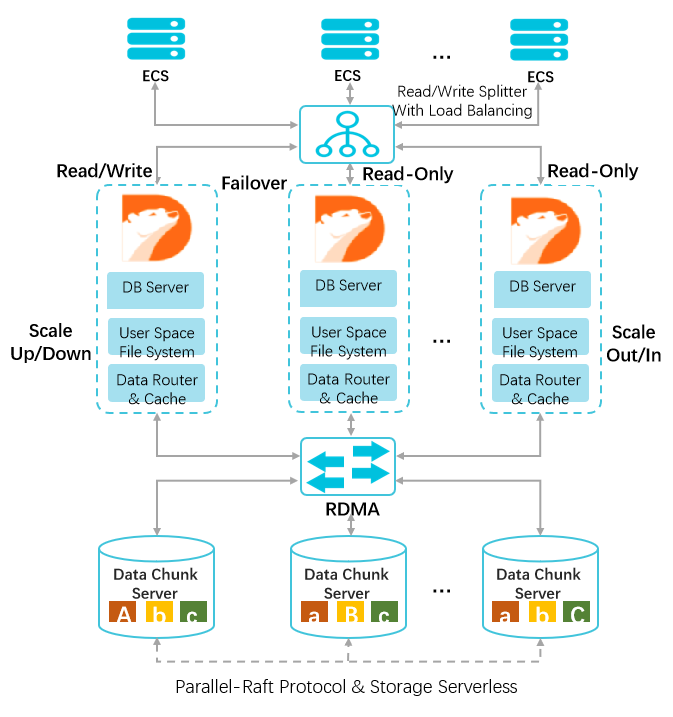Apsara PolarDB is no doubt a next-generation relational database that is developed by Alibaba Cloud. PolarDB includes three independent engines. This ensures that PolarDB is fully compatible with MySQL and PostgreSQL. It also ensures that PolarDB databases are compatible with the Oracle syntax. Each PolarDB cluster can support a maximum storage space of 100 TB. You can add a maximum of 16 nodes to each PolarDB cluster. PolarDB can be applied to several different scenarios.
PolarDB uses an architecture that allows you to decouple and separate computing and storage. In this case, all compute nodes share the same physical storage. PolarDB allows you to upgrade or downgrade instance specifications within minutes, and to perform fault recovery within seconds. ApsaraDB for PolarDB ensures global data consistency. It also provides data backup and disaster recovery services free of charge. PolarDB for MySQL has the benefits of both commercial databases and open-source cloud databases. Commercial databases are stable and scalable and have high performance. Open source cloud databases are easy to use and feature rapid iteration. For example, the performance of PolarDB for MySQL is six times that of MySQL. However, the cost of a PolarDB for MySQL database is only 10% that of a commercial database.
See how PolarDB can save you from tedious operations, exhausted troubles, and challenges coming from uncertainty.
PolarDB is compatible with a variety of popular relational database engines. It is fully compatible with MySQL and PostgreSQL, and is highly compatible with Oracle syntax, with little or no code and application modification.
Apsara PolarDB uses distributed block storage and a file system to allow automatic scale-up of database storage capacity, regardless of the storage capacity of each node. This enables your database to handle up to hundreds of terabytes of data.
Based on the snapshot technology of underlying distributed storage, Apsara PolarDB requires only a few minutes to back up a database with TB-level data. During the entire backup process, no lock is required, which delivers higher efficiency and minimizes the negative impact.
ApsaraDB PolarDB uses a cloud-native architecture. PolarDB takes advantage of the benefits of commercial databases and open-source cloud databases. Commercial databases offer the following benefits: stability, reliability, high performance, and scalability. Open source cloud databases offer the following benefits: simplicity, openness, and rapid iteration. This topic describes the architecture and features of PolarDB.

PolarDB uses a distributed cluster-based architecture. Each standard PolarDB cluster consists of a primary node and a maximum of 15 read-only nodes. At least one read-only node must be used to implement failovers to ensure the high availability of PolarDB databases. The primary node processes read and write requests and the read-only nodes process only read requests. PolarDB uses an active-active architecture for the primary node and read-only nodes in each cluster. This architecture allows you to implement failovers to ensure the high availability of PolarDB databases.
PolarDB decouples compute from storage. This allows you to scale clusters that are deployed on Alibaba Cloud to meet your business requirements. Compute nodes store only metadata and remote storage nodes store data files and redo logs. Database engine servers function as compute nodes and database storage servers function as storage nodes. You need only to synchronize the metadata of redo logs among your compute nodes. This reduces the replication delay between the primary node and read-only nodes. If the primary node fails, a read-only node can function as the primary node in a short period.
By default, read/write splitting is enabled for PolarDB clusters. The read/write splitting feature is available for free. This feature is transparent to users. This feature provides the capabilities of high availability and self-adaptive load balancing. The read/write splitting feature automatically forwards SQL requests to each node of PolarDB clusters based on cluster endpoints. This allows you to process a large number of concurrent SQL requests in high-throughput scenarios. For more information, see Read/write splitting.
High-speed network connections are used between compute nodes and storage nodes of PolarDB databases. The Remote Direct Memory Access (RDMA) protocol is used for data transmission between compute nodes and storage nodes. These two features eliminate the bottlenecks of I/O performance.
In PolarDB, compute nodes share one set of data. This reduces your storage costs. PolarDB uses distributed storage and the distributed file system. This allows you to perform online scale-ups to increase the storage capacity of databases in a smooth manner. The online scale-ups are not affected by the storage capacity of each individual database server. The online scaling allows your databases to process hundreds of terabytes of data.
Storage nodes of PolarDB databases maintain multiple data replicas to ensure reliability and use the Parallel-Raft protocol to ensure data consistency among these replicas.
ApsaraDB for PolarDB is widely adopted by users in New Retail, Gaming, Internet Finance, and Live-streaming.
PolarDB supports scenarios challenged by high concurrency and sudden traffic volume increase, such as in promotions and flash sales. Instances can be scaled out within seconds, meeting the read/write requirements for enterprise-level large-scale data analysis. Scale-out events can be quickly implemented and the availability of database clusters is enhanced while keeping storage costs at a minimum.
ApsaraDB for PolarDB is a cloud-native relational database compatible with MySQL, PostgreSQL, and Oracle. ApsaraDB for PolarDB provides the performance and availability of traditional enterprise databases and the flexibility and cost-effectiveness of open-source databases.
ApsaraDB for PolarDB is designed for business-critical database applications that require fast performance, high concurrency, and automatic scaling. You can scale up to millions of queries per second and 100 TB per database cluster with 15 low latency read replicas. ApsaraDB for PolarDB is six times faster than standard MySQL databases and delivers the security, reliability, and availability of traditional commercial databases at 1/10 the cost. ApsaraDB for PolarDB embodies the proven database technology and best practices honed over the last decade that supported hyper-scale events such as the Alibaba Double 11 Global Shopping Festival.
On November 11, 2018, ApsaraDB for PolarDB successfully supported 1 billion orders in 24 hours, during which the number of queries received per second spiked by 122 times.
100% compatible with open-source MySQL and RDS MySQL.
Decouple of computing and storage, extreme auto-scaling, lower TCO.
High compatible with Oracle syntax, supports migration from all Oracle versions.
Real-World Implementation of Data Analytics with Alibaba Cloud: DataV and Visualization (Part 5)

2,593 posts | 791 followers
FollowJDP - August 12, 2021
Alibaba Clouder - February 3, 2021
JDP - July 9, 2021
JDP - August 27, 2021
Alibaba Clouder - February 8, 2021
ApsaraDB - December 28, 2025

2,593 posts | 791 followers
Follow PolarDB for PostgreSQL
PolarDB for PostgreSQL
Alibaba Cloud PolarDB for PostgreSQL is an in-house relational database service 100% compatible with PostgreSQL and highly compatible with the Oracle syntax.
Learn More PolarDB for Xscale
PolarDB for Xscale
Alibaba Cloud PolarDB for Xscale (PolarDB-X) is a cloud-native high-performance distributed database service independently developed by Alibaba Cloud.
Learn More PolarDB for MySQL
PolarDB for MySQL
Alibaba Cloud PolarDB for MySQL is a cloud-native relational database service 100% compatible with MySQL.
Learn More ApsaraDB RDS for MariaDB
ApsaraDB RDS for MariaDB
ApsaraDB RDS for MariaDB supports multiple storage engines, including MySQL InnoDB to meet different user requirements.
Learn MoreMore Posts by Alibaba Clouder